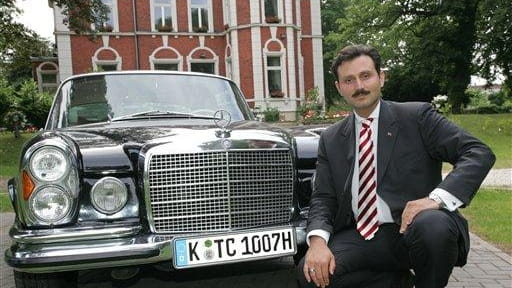Classic car insurance: Get an Agreed Value policy before the next storm

Turk Fevzi Cebe, president of the Union of European Turkish Democrats, poses beside his 1971 Mercedes 280 SE 3.5 coupe in front of the party headquarters in Cologne, Germany. (June 16, 2006) Credit: AP
I think that over the past few months I’ve received more e-mails about classic car insurance than any other subject that I’ve written about. Sadly, most of the inquiries were related to classic cars and motorcycles that were lost during superstorm Sandy. We’ve explored this subject in the past, but perhaps it’s time to review it again.
Generally speaking, auto insurance comes in two varieties - Actual Cash Value (ACV), and Agreed Value (sometimes called Stated Value). The difference between the two could not possibly be more important to classic car owners, yet many owners pay no attention to their policies, and this is where the problems arise.
With an ACV policy, the value of your vehicle is determined at the time of a loss. More importantly, the value is determined by your insurance company. Of course you can argue with them about the value that they assign, and you might be successful to some small degree, but there is little that you can do if you disagree with their value. This is the type of policy that most of us have on our “daily drivers.”
With an Agreed Value Policy, the value of the car is determined when you take out the policy. Unless you are placing a ridiculous value on your classic car, the insurance company will usually agree to it, although they might require an appraisal. If there is a loss, you get a check. No questions asked, no arguing, no negotiating. Best of all, these policies are a fraction of the cost of an ACV policy. This is the type of policy that most of us have on our classic cars…or should have. But many do not.
Surprisingly, many people do not know that Agreed Value policies designed specifically for classic cars exist, and even more surprisingly neither do their insurance agent so they end up with an ACV policy on their classic car. This is the problem that I’ve encountered most frequently in the wake of Sandy. An example is a 1959 Cadillac Series 62 Convertible that was lost in Hurricane Sandy. The owner had an ACV policy and the insurance company offered to pay $5,500. We are now trying to prove that the ACV was actually in the range of $75,000. If the owner had an Agreed Value policy she would be out shopping for another 1959 Cadillac convertible right now instead of fighting with the insurance company. These people I can help.
I can’t help the ones who were smart enough to by an Agreed Value policy, but not smart enough to increase the coverage as the car increased in value. An example is the owner of a 1971 Mercedes Benz 280SE Cabriolet that was lost in Hurricane Sandy. The owner insured the car for $40,000 when he purchased it five years ago. He never increased his coverage. Today the car is…I should say was worth about $200,000. All it would have taken was a telephone call and a slightly higher premium, and he would have gotten a check for $200,000 instead of $40,000.
By now you may be wondering why we don’t all have Agreed Value policies on all of our cars including our daily drivers.
Companies that provide insurance coverage on classic cars can offer these Agreed Value policies at a fraction of the cost of an ACV policy for one reason. They have figured out how to greatly reduce their exposure to loss. And less loss means less claims that they have to pay. And less claims that they have to pay means greater saving that they pass along to us…classic car owners. The way that they reduce this exposure to loss is by limiting how we are allowed to use our classic cars. These limits include things such as caps on annual mileage, limiting use to pleasure only, not being allowed to use our classic car as a replacement for our daily driver when it breaks down, and having at least one registered car for every licensed driver in the household.
These limits don’t greatly impinge on the way we use our classic cars. But they would be untenable if applied to our daily drivers, and that’s why we don’t have Agreed Value policies on our daily drivers.
Now that you have this information, the rest is up to you. Make sure that you have a policy that’s appropriate for your classic car. If it’s an ACV policy, consider getting an appraisal before you suffer a loss. This way you have something with which to counter an offer from your insurance company that you might consider unreasonable. And if you already have an Agreed Value policy, make sure that you have the right amount of coverage. The next storm could be right around the corner.
